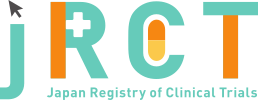臨床研究等提出・公開システム
|
Aug. 01, 2017 |
|
|
Dec. 08, 2023 |
|
|
jRCT1080223606 |
Treatment Preference for Weekly Dipeptidyl Peptidase-4 (DPP-4) Inhibitors Versus Daily DPP-4 Inhibitors in Patients With Type 2 Diabetes Mellitus |
|
Public Title Treatment Preference for Weekly DPP-4 Inhibitors Versus Daily DPP-4 Inhibitors in Participants With Type 2 Diabetes Mellitus (TRINITY) |
|
Feb. 09, 2018 |
|
60 |
|
Demographic and other baseline characteristics were similar between groups. |
|
A total of 60 participants signed the informed consent form. All participants met the eligibility criteria for randomization into the treatment period of the study. Overall, 30 participants were randomized to the T-A group and 30 participants were randomized to the A-T group. All participants in the T-A group completed the planned study treatment. Two participants in the A-T group did not complete the planned study treatment (pretreatment event/AE, n = 1; and other, n = 1). |
|
Eight patients in the trelagliptin group (13.6%; 8/59 patients) and four patients in the alogliptin group (6.7%; 4/60 participants) experienced a treatment-emergent AE (TEAE), the majority of which were mild in intensity. One patient (1.7%) in each group experienced a TEAE of moderate intensity. One patient (1.7%) in the trelagliptin group experienced two serious TEAEs that led to study drug discontinuation. Examination of this patients' intestinal obstruction revealed colon cancer, both of which resulted in trelagliptin discontinuation in the A-T group. Infections and infestations were the most common non-serious TEAE by SOC in the trelagliptin and alogliptin group, experienced by six patients (10.2%) and three patients (5.0%), respectively. Two patients (3.4%) in the trelagliptin group, and one patient (1.7%) in the alogliptin group experienced a viral upper respiratory tract infection. Two patients (3.4%) in the trelagliptin group only experienced an upper respiratory tract infection. No deaths were reported during this study. No drug-related TEAEs or drug-related serious AEs were reported during this study. Conclusions: Trelagliptin 100 mg and alogliptin 25 mg were well-tolerated and no new safety signals were identified. |
|
At 16 weeks, patients expressed a significantly higher treatment preference for alogliptin (51.7%, n = 31) than trelagliptin (30.0%, n = 18) in both groups combined (T-A and A-T) (Mainland-Gart test, p=0.0141). In the T-A group alone, 60.0% of patients preferred alogliptin, and 26.7% of patients preferred trelagliptin. In the A-T group alone, 43.3% and 33.3% of patients preferred alogliptin and trelagliptin, respectively. At 16 weeks, patients who received at least one dose of both trelagliptin and alogliptin also expressed a significantly higher treatment preference for alogliptin (50.8%) than trelagliptin (30.5%) in both groups combined (T-A and A-T) (Mainland-Gart test, p=0.0231). In the T-A group alone, 60.0% of patients preferred alogliptin and 26.7% of patients preferred trelagliptin. In the A-T group alone, 41.4% and 34.5% of patients preferred alogliptin and trelagliptin, respectively. |
|
At 16 weeks, treatment preference by background factors (demographic and baseline characteristics) revealed a greater preference for alogliptin than trelagliptin in both groups combined (T-A and A-T), which support the results of the primary endpoint. Conclusions: At the end of the 16-week study, patients expressed a significantly higher treatment preference for once-daily alogliptin 25 mg than once-weekly trelagliptin 100 mg. Treatment satisfaction after 8 weeks was numerically higher in the alogliptin, and trelagliptin group compared with baseline. Additionally, HbA1c in both treatment groups was comparable to baseline. |
|
The decision to administer once-weekly or once-daily DPP-4 inhibitor treatment is likely to depend on patient preference, patient-physician discussions (i.e., patientcentered communications), and the treatment practices of the treating physician. Refer to conclusions of "Adverse Events" and "Secondary Outcome Measures" sections for the rest of the summary. |
|
Yes |
|
Takeda makes patient-level, de-identified data sets and associated documents available for all interventional studies after applicable marketing approvals and commercial availability have been received, an opportunity for the primary publication of the research has been allowed, and other criteria have been met as set forth in Takeda's Data Sharing Policy (see www.TakedaClinicalTrials.com/approach for details). To obtain access, researchers must submit a legitimate academic research proposal for adjudication by an independent review panel, who will review the scientific merit of the research and the requestor's qualifications and conflict of interest that can result in potential bias. Once approved, qualified researchers who sign a data sharing agreement are provided access to these data in a secure research environment. |
|
| version: date: |
Takeda Pharmaceutical Company Limited |
||
https://www.takeda.com/jp/who-we-are/contact-us/ |
||
+81-6-6204-2111 |
||
- |
Takeda Pharmaceutical Company Limited |
||
https://www.takeda.com/jp/who-we-are/contact-us/ |
||
+81-6-6204-2111 |
||
- |
completed |
Aug. 18, 2017 |
||
| 60 | ||
Interventional |
||
Randomized, open-label, two-way crossover |
||
treatment purpose |
||
4 |
||
1. Participants who have been diagnosed with type 2 diabetes mellitus. |
||
1. Participants who have a history of taking once-weekly dosing of DPP-4 inhibitor (trelagliptin or omarigliptin). |
||
| 20age old over | ||
| No limit | ||
Both |
||
Type 2 diabetes mellitus |
||
investigational material(s) |
||
efficacy |
||
efficacy |
||
| TAKEDA PHARMACEUTICAL COMPANY LTD. | |
| - |
| - | |
| - |
| Keio University Independent Ethics Committee | |
| 35, Shinanomachi, Shinjuku-ku, Tokyo | |
- |
|
| - | |
| approved | |
Aug. 05, 2017 |
| NCT03231709 | |
| ClinicalTrials.gov |
| JapicCTI-173662 | |
| Japan |
